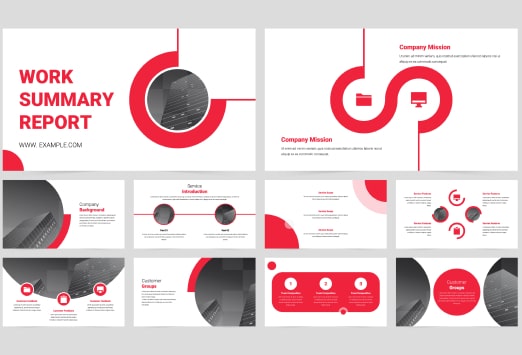Creative Presentation Design Ideas to Wow Your Audience

Are you tired of delivering uninspiring presentations that leave your audience feeling bored? If so, it's time to inject some creativity into your presentation design! In this article, we will explore 10 innovative ideas that will wow your audience and make your presentations truly unforgettable.
Table of Contents
- Understanding why creativity is important in presentation design
- How design impacts audience engagement
- What makes a standout presentation?
- Innovative presentation design ideas
- How to implement creative presentation design
- How to measure the success of your presentation
Understanding the importance of creative presentation design
When it comes to presentations, design plays a crucial role in capturing your audience's attention and conveying your message effectively. Creative presentation design sets you apart from the crowd and helps you make a lasting impression. But why is creativity so important in presentations?
Let's delve deeper into the subject and explore the various aspects of creative presentation design.
The role of creativity in effective presentations
Creativity adds depth and originality to your presentation, making your content more engaging and memorable. It allows you to think outside the box and present information in a way that is not only informative but also visually appealing.
Imagine attending a presentation where the speaker simply reads off a series of bullet points from a plain, uninspiring slide. Now, compare that to a presentation where the speaker uses captivating visuals, innovative layouts, and interactive elements to bring their content to life. Which one would you find more engaging and memorable?
By incorporating unique design elements, you can stimulate your audience's curiosity and create an immersive experience that keeps them hooked throughout. Whether it's using striking images, compelling infographics, or interactive charts, creativity in design helps you tell a story and captivate your audience's attention.
How design impacts audience engagement
1. Audience Engagement
The design of your presentation directly impacts how your audience engages with your content. An aesthetically pleasing and well-thought-out design not only captures attention but also helps convey information more effectively.Think about it - when you see a visually appealing slide, your eyes are naturally drawn to it. This initial visual engagement piques your interest and encourages you to pay closer attention to the content being presented. On the other hand, a poorly designed slide with cluttered text and confusing visuals can quickly disengage your audience and make it difficult for them to grasp the key points.
2. Comprehension & Connection
The right design choices can enhance comprehension, drive emotional connection, and inspire action. By using appropriate colour schemes, typography, and layout, you can create a visual hierarchy that guides your audience's attention to the most important information. This not only helps them understand your message better but also makes it easier for them to retain the information in their memory.A well-designed presentation can evoke emotions and create a connection with your audience. By using imagery and visuals that resonate with your message, you can tap into the viewer’s emotions and make a lasting impact. Whether it's through inspiring photographs, relatable illustrations, or thought-provoking videos, creative design choices can help you establish a deeper connection with your audience.
3. Drive Action
Lastly, an effective presentation design can inspire action. By presenting your content in a visually compelling manner, you can motivate your audience to take the desired action. Whether it's encouraging them to sign up for a service, support a cause, or invest in a product, a well-designed presentation can influence their decision-making process and drive them towards the desired outcome.
In conclusion, creativity in presentation design is crucial for capturing and maintaining your audience's attention. By incorporating unique design elements, you can make your content more engaging, memorable, and impactful. So, the next time you prepare a presentation, don't underestimate the power of creative design - it can make all the difference in delivering a successful presentation.
What makes a standout presentation?
Before we dive into the creative design ideas, let's explore the key elements that make a presentation stand out. When it comes to creating a standout presentation, there are several factors to consider.
Colour Scheme
One of the most important elements is the choice of colour scheme. Colour has a powerful impact on emotions and can evoke specific moods. Selecting a coherent and visually appealing colour scheme can create a harmonious atmosphere and strengthen your message. It’s important to make sure that your presentation design is coherent with your overall branding. Use the correct brand colours by using hex codes to ensure accuracy across all marketing collateral. Incorporating your branding helps to bring an overall sense of professionalism to your presentation.
Typography
In addition to colour, typography also plays a vital role in conveying your message effectively. Choosing the right font, size, and style helps emphasise key points, improve readability, and deliver a cohesive visual experience. For instance, using a bold and large font for headings can grab the audience's attention, while a clean and legible font for body text ensures easy readability. It's important to strike a balance between creativity and readability when selecting typography for your presentation.
Visuals
Another crucial aspect of creating a standout presentation is the effective use of images and graphics. Visuals are a potent tool to engage your audience and enhance understanding. Incorporating relevant images and graphics can make complex concepts more accessible and memorable. For example, if you're presenting data or statistics, using charts or graphs can help visualise the information and make it easier for your audience to grasp. Additionally, including high-quality images that relate to your topic can add visual interest and create a more immersive experience for your viewers.
By carefully considering the colour scheme, typography, and the use of visuals, you can elevate your presentation and make it truly standout. These elements work together to create an appealing and engaging experience for your audience, helping them better understand and remember your message.
Innovative presentation design ideas
Now that we've discussed the essential elements, let's explore some innovative design ideas to make your presentations truly outstanding.
When it comes to creating a memorable presentation, it's crucial to think beyond conventional design and incorporate unique elements that will captivate your audience.
Here are a few ideas to consider:
Interactive presentations: Engaging your audience
Interactive presentations involve audience participation, encouraging your listeners to actively engage with the content. By incorporating activities, quizzes, or live polls, you can create an interactive experience that captures attention and promotes learning.
Imagine starting your presentation with a thought-provoking question and allowing your audience to respond using their smartphones or tablets. This not only gets them involved from the beginning but also provides valuable insights that you can refer back to throughout your presentation.
Another interactive idea is to incorporate group activities that require collaboration. This not only breaks the monotony of a traditional presentation but also encourages teamwork and engagement among your audience members.
Make sure to include these interactive elements in a way that makes sense to the overall design of your presentation. Using brand colours and iconography that fits with your brand guidelines is one way to do this, and helps to ensure an overall consistent and professional look.

Storytelling through design
Humans are naturally drawn to stories. Leveraging the power of storytelling in your presentation design can captivate your audience and make your message more relatable. Consider structuring your presentation as a narrative, using visuals and anecdotes to enhance the storytelling experience.
Infographics in your presentation can visually portray your data and ideas in a way that is simple and engaging. By using charts, graphs and other data visualisation, you can drive home the real meaning behind the numbers and help your audience have a better understanding. Instead of simply presenting facts and figures, you can weave a story around them. This not only keeps them engaged but also helps them connect emotionally with your message.
Additionally, you can tell a story through the use of the images in each presentation. For example if your business is pitching about the impact of your product on the environment, you could help to tell this story further through the use of images that reflect nature or other organic materials. Design should always help to compliment and strengthen the narrative, rather than distract from it.
Minimalist design for maximum impact
In design, simplicity is often key. Minimalist design focuses on removing unnecessary clutter and distilling your message to its essence. By embracing clean lines, ample white space, and simple visuals, you can create a minimalist presentation that focuses on the core message and leaves a lasting impact.
When adopting a minimalist approach, it's important to carefully choose your visuals and use them sparingly. Each visual should serve a purpose and contribute to the overall message you want to convey. By doing so, you create a visually appealing presentation that is easy to understand and remember.
Furthermore, consider using typography as a design element. Experiment with different fonts, sizes, and styles to create visual hierarchy and guide your audience's attention to key points. Remember, less is more when it comes to minimalist design.
By incorporating these innovative design ideas into your presentations, you can elevate your content and leave a lasting impression on your audience. Remember to experiment, be creative, and always keep your audience's needs and preferences in mind.

Tips for implementing creative design ideas
Now that we've explored creative design ideas, it's essential to understand how to implement them effectively.
Balancing creativity and clarity
While creativity is crucial, it's essential to strike a balance between eye-catching design and clarity. Ensure that your design choices enhance comprehension rather than detract from it. Use clear and concise language alongside visually appealing elements.
Adapting design ideas to your presentation's purpose
Consider the audience, topic, and objective of your presentation when implementing design ideas. Tailor your design choices to align with your presentation's purpose, ensuring that they support and enhance your content rather than overshadowing it.
Measuring the success of your presentation design
Once you've delivered your creatively designed presentation, it's essential to evaluate its impact.
Evaluating audience response
Engage with your audience post-presentation to gather feedback and assess their response. This feedback will provide valuable insights into the effectiveness of your design choices and help you refine your approach for future presentations.
Reflecting on your design process and outcomes
Take time to reflect on your design process and outcomes to identify what worked well and areas for improvement. Learning from your experience will enable you to continually refine your presentation design skills and stay ahead of the game.
With these creative presentation design ideas, you can take your presentations to the next level and wow your audience with impactful and engaging visuals. Embrace your creativity, experiment with different design elements, and watch as your audience becomes captivated by your presentations like never before.



